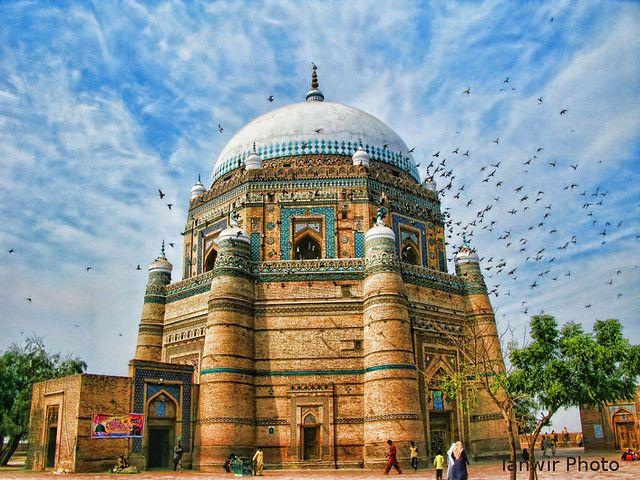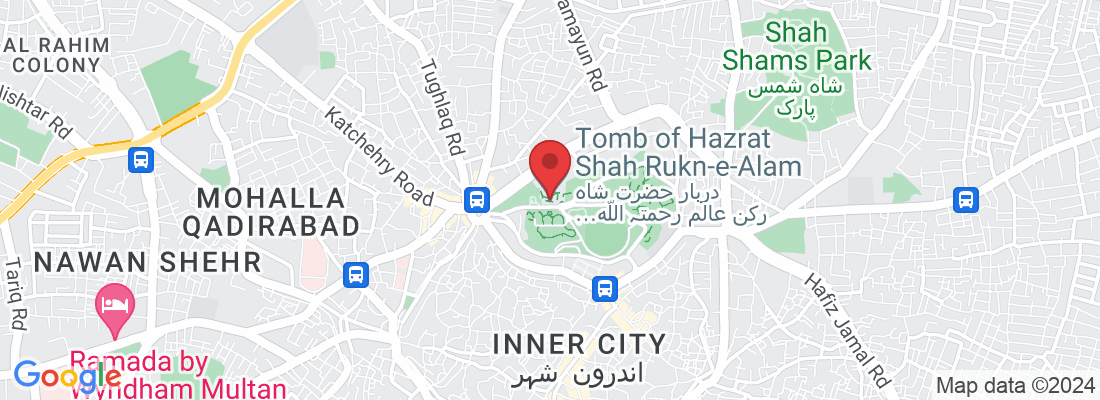MULTAN
City Of Saints
City Of Saints
Tomb of Shah Rukn-e-Alam

Tomb of Shah Rukn-e-Alam: The Pride of Multan:
The Tomb of Shah Rukn-e-Alam Multan stands as one of the most famous Sufi shrines in Pakistan and a symbol of the ancient civilization of Multan. Built in the 14th century, this historic tomb is the resting place of the revered Sufi saint Hazrat Shah Rukn-e-Alam, who is celebrated for spreading Islam and Sufism in the region.
Historical Background:
Shah Rukn-e-Alam, also known as Sheikh Rukn-ud-Din Abul Fateh, was a revered Sufi saint of the 14th century. Born in 1251 CE, he was a prominent figure in the Suhrawardi Sufi order and played a crucial role in spreading the teachings of Islam in the region. His spiritual influence and teachings left a lasting impact on the people of Multan and beyond.The tomb was constructed between 1320 and 1324 CE by Ghiyath al-Din Tughluq, the ruler of the Delhi Sultanate, as a tribute to the saint’s esteemed spiritual status.Initially intended to serve as a tomb for Ghiyath al-Din himself, it was later gifted to the descendants of Shah Rukn-e-Alam, who had his remains interred in the shrine in 1330.
Architectural Marvel:
The Tomb of Shah Rukn-e-Alam is a masterpiece of Tughluq architecture, characterized by its grandeur and intricate design. The mausoleum is a three-tiered structure with an octagonal base, which is a distinctive feature of Multani funerary architecture. The exterior of the tomb is adorned with intricate tile work, featuring a captivating color palette of dark blue, azure, and white, which contrasts beautifully with the deep red tone of the polished bricks. The shrine’s layout includes three entrances, a western-facing mihrab, and an original main entrance on the southern axis. The main entrance has since been shifted to the east to align the shrine’s axes with Mecca, in accordance with orthodox interpretations of Islam. The mausoleum also features buttresses in each of its eight corners, incorporating elements of Tughluq military architecture.
Someone says about him:
ملتانی مٹی کا روشن چراغ
حضرت شاہ رکنِ عالم کی عظمت کا باغ
صوفیٔ اعظم، دلوں کے مکیں
ہر قلب میں ہے آپ کا ذکرِ حسیں۔
Cultural Significance:
The Tomb of Shah Rukn-e-Alam is not only an architectural wonder but also a significant cultural and religious site. It attracts over 100,000 pilgrims annually during the urs festival, which commemorates the saint’s death. The shrine is a focal point for devotion and pilgrimage, drawing visitors from all over Pakistan and beyond.The spiritual significance of the shrine is further enriched by the countless tales of miracles associated with Shah Rukn-e-Alam. Many believe that the saint possessed miraculous healing powers, and countless individuals suffering from ailments, both physical and spiritual, have sought solace at the shrine and experienced miraculous recoveries.
Plan Your Visit to Shah Rukn-e-Alam:
Located near the historic Multan Fort, the Tomb of Shah Rukn-e-Alam Multan is a must-see for anyone exploring the cultural and spiritual treasures of the city. Visiting this famous Sufi shrine in Pakistan lets you experience the timeless beauty and peaceful atmosphere that define Multan Sufi heritage. For tourists looking for the best places to visit in Multan, this magnificent tomb is truly unmissable.
Short Words:
The Tomb of Shah Rukn-e-Alam is a true gem of Multan, embodying the rich cultural, spiritual, and architectural heritage of the region. Whether you are a history enthusiast, a spiritual seeker, or an architecture aficionado, a visit to this magnificent shrine is a must. Its timeless beauty and profound significance make it a landmark that continues to inspire and captivate visitors from around the world.
Who was Shah Rukn-e-Alam?
Shah Rukn-e-Alam, also known as Sheikh Rukn-ud-Din Abul Fateh, was a prominent 13th and 14th-century Sufi saint from Multan, Pakistan. He belonged to the Suhrawardiyya Sufi order and is revered for his spiritual teachings and piety.
Where is the tomb of Shah Rukn-e-Alam located?
The tomb of Shah Rukn-e-Alam is situated in Multan, Punjab, Pakistan. It is located at the northwestern edge of the Multan Fort.
What is the historical significance of the tomb?
The tomb is considered the earliest example of Tughluq architecture and is one of the most impressive shrines in the Indian subcontinent. It was built between 1320 and 1324 CE by Ghiyath al-Din Tughluq and later gifted to the descendants of Shah Rukn-e-Alam for his burial.
What architectural features does the tomb have?
The mausoleum is a three-tiered structure with an octagonal base, typical of Multani funerary architecture. It features intricate tile work, frescoes, and calligraphic masterpieces. The exterior is adorned with glazed tiles in dark blue, azure, and white, contrasting beautifully with the red bricks.
What is the annual urs festival?
The annual urs festival commemorates the death of Shah Rukn-e-Alam and attracts over 100,000 pilgrims from all over South Asia. It is a time of spiritual reflection and celebration of the saint’s life and teachings.
Are there any legends associated with Shah Rukn-e-Alam?
Yes, there are numerous tales of miracles attributed to Shah Rukn-e-Alam. Many believe that he had miraculous healing powers, and countless individuals have reported experiencing recoveries from ailments after visiting his shrine.
Who was Shah Rukn-e-Alam?
Shah Rukn-e-Alam, also known as Sheikh Rukn-ud-Din Abul Fateh, was a prominent 13th and 14th-century Sufi saint from Multan, Pakistan. He belonged to the Suhrawardiyya Sufi order and is revered for his spiritual teachings and piety.
Where is the tomb of Shah Rukn-e-Alam located?
The tomb of Shah Rukn-e-Alam is situated in Multan, Punjab, Pakistan. It is located at the northwestern edge of the Multan Fort.
What is the historical significance of the tomb?
The tomb is considered the earliest example of Tughluq architecture and is one of the most impressive shrines in the Indian subcontinent. It was built between 1320 and 1324 CE by Ghiyath al-Din Tughluq and later gifted to the descendants of Shah Rukn-e-Alam for his burial.
What architectural features does the tomb have?
The mausoleum is a three-tiered structure with an octagonal base, typical of Multani funerary architecture. It features intricate tile work, frescoes, and calligraphic masterpieces. The exterior is adorned with glazed tiles in dark blue, azure, and white, contrasting beautifully with the red bricks.
What is the annual urs festival?
The annual urs festival commemorates the death of Shah Rukn-e-Alam and attracts over 100,000 pilgrims from all over South Asia. It is a time of spiritual reflection and celebration of the saint’s life and teachings.
Are there any legends associated with Shah Rukn-e-Alam?
Yes, there are numerous tales of miracles attributed to Shah Rukn-e-Alam. Many believe that he had miraculous healing powers, and countless individuals have reported experiencing recoveries from ailments after visiting his shrine.
How can I visit the tomb?
The tomb is open to visitors throughout the year. It is located within the Multan Fort, and you can easily reach it by local transport or guided tours available in Multan.
We use cookies to ensure that we give you the best experience on our website.
© Copyright Multan 2024


Facebook
LinkedIn